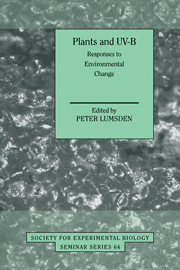Preface
Published online by Cambridge University Press: 04 August 2010
Summary
Public awareness of the dangers to health of exposure to ultraviolet (UV) light has increased in recent years. Although exposure to UV can have positive effects on humans – sunbathing generally induces a feeling of well-being, partly due to production of natural endorphins, and stimulation of synthesis of vitamin D – the dangers far outweigh the benefits. The most noticeable effect of exposure is sunburn, or erythema; more serious is the increase in risk of skin cancer, and of damage to the eyes, and these symptoms may not surface for several years. At the same time, the public has also become aware that protection from solar UV is provided by ozone in the upper atmosphere, the stratosphere, but that, over recent years, the ozone layer has suffered depletion due to the action of man-made chemicals. The predicted result of this is that more UV radiation from the sun will reach the earth's surface.
Energy from the sun covers the whole electromagnetic spectrum, from short gamma rays (10−5 nm) to long radio waves (103 m). UV light is that region of the spectrum with shorter wavelengths than blue light, between about 400 nm and 250 nm, and this is divided still further into UV-A (400–320 nm); UV-B (320–280 nm) and UV-C (280–250 nm). UV-A does not interact with ozone, since individual photons do not carry enough energy to carry out the necessary photochemical reactions; the energy in UV-B is used in breaking the bonds between oxygen atoms in molecules of ozone, which effectively results in absorption of the UV-B; UV-C is effectively absorbed by ozone/oxygen, and would still be so even under high depletions of ozone.
- Type
- Chapter
- Information
- Plants and UV-BResponses to Environmental Change, pp. xiii - xxPublisher: Cambridge University PressPrint publication year: 1997

